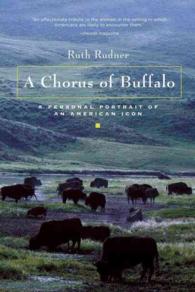- ホーム
- > 洋書
- > 英文書
- > Nature / Ecology
Full Description
At the centre of the elephant tourism industry lie two profound challenges: the delicate balance between income and compassion, and the severe threats to the survival of all remaining elephant species. Trained elephants exchange hands for staggering sums, reaching up to $100,000 each, yet the colossal appetites of the herds, with each elephant devouring over 100 kilograms of sustenance daily, pose formidable economic challenges for camp owners. An elephant camp's revenue is dependent on tourism, with a complex web of specialist businesses, local and international, large and small, contracted to recruit and enable visitors. This results in competition focused mainly on price and profitability considerations. The inadequacies of these business networks and of the administrative controls within which they operate were demonstrated during the complete shutdown of elephant tourism venues in early 2020 due to COVID-19. This authoritative text analyses elephants' vulnerabilities, providing an inspiring call to action for a more compassionate coexistence between elephants and the stakeholders responsible for their individual and herd welfare and survival. Elephant Welfare in Global Tourism is intended for managers, professionals and administrators of elephant camps, refuges and rescue centres, and for NGOs providing advice and support. Academic researchers on wildlife may find inspiration for suitable topics, and examples of current methodologies.
Contents
Chapter 14: Afterword Chapter 1: A Problems Approach to Human-Elephant Interactions Chapter 10: The UK Animals (Low Welfare) Act Chapter 11: The UK Trophy Hunting Import Ban, Hansard Chapter 12: UK Zoos Captive Elehants Rregulations, DEFRA Chapter 2: Sustainable Elephant Tourism, Gender Perspectives Chapter 3: The Complexity of Foraging and its Role in Elephant Well-being Chapter 4: Human Enjoyment of Interaction with Elephants Chapter 5: Redefining Elephant-Human Relationships through Actor-Network Theory Chapter 6: Can Symbolic Value and Religious Beliefs Save Elephants' Lives? Chapter 7: Turning Threats into Opportunities for Communities and Elephants in North-eastern Botswana Chapter 8: COVID-19 and Elephant Tourism Chapter 9: Regulating and Monitoring the Asian Captive Elephant Industry Chapter 13: Conclusion Section 1:: Elephant Problems Section 2:: Conservation Challenges and Solutions Section 3:: Analysing Human-Elephant Conflicts Section 4:: Regulation and Legislation








